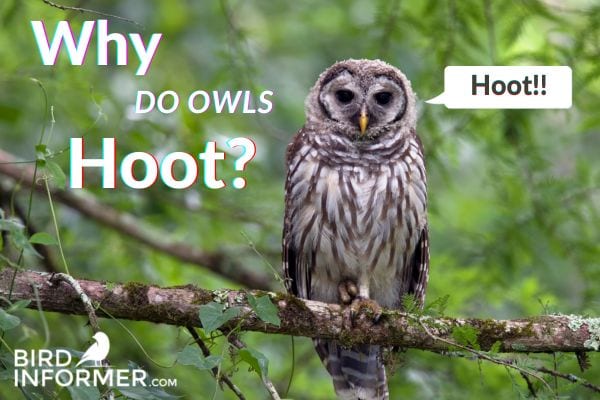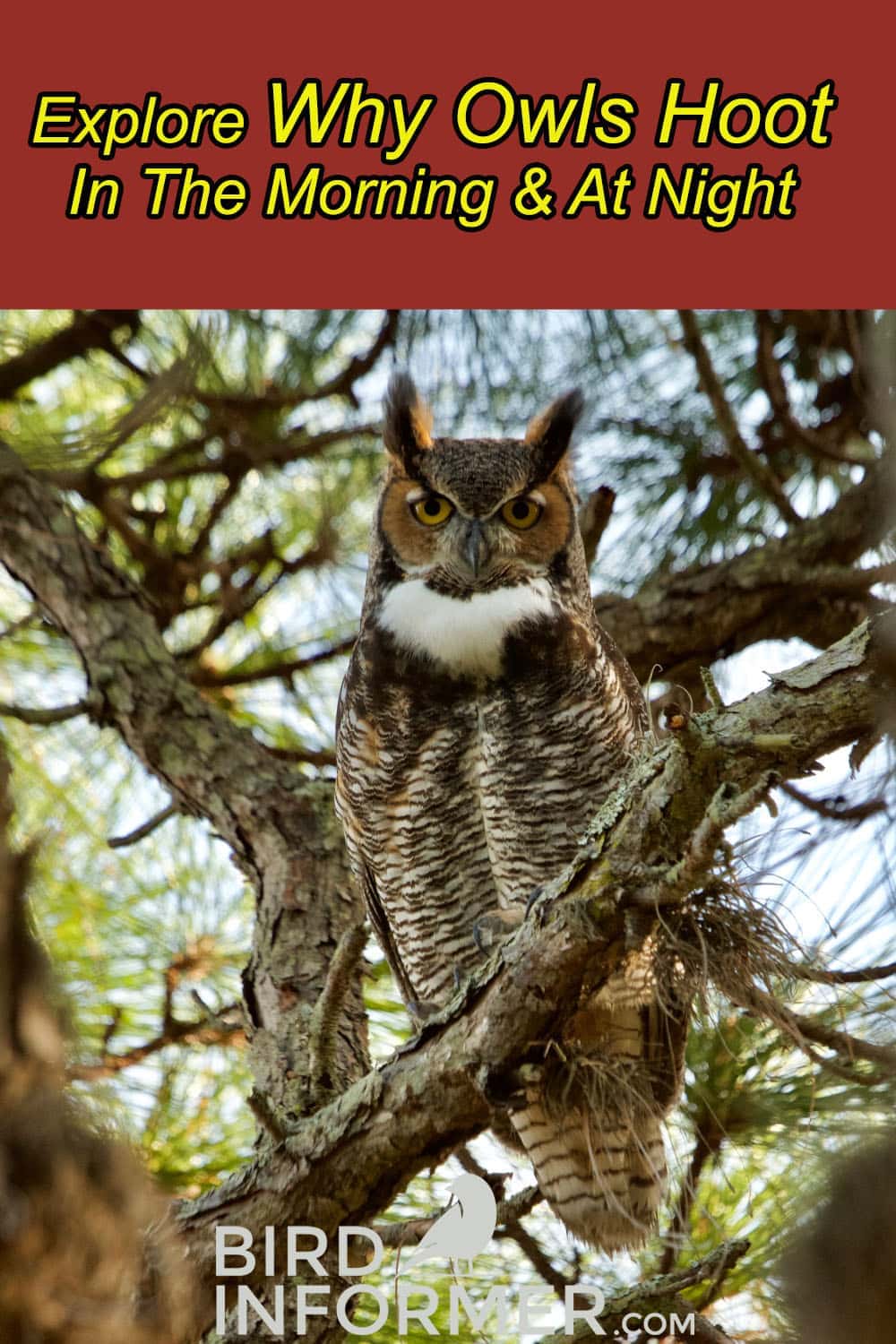Contents
Updated: May 11, 2023
Different birds create different sounds, and owls are known for their hooting. But as most owls are nocturnal, it’s still a wonder for most people why they hear owls hooting at sunrise and sunset.
Like many other birds, owls hoot for different reasons, including protecting their territory, during courtship, when they feel threatened, etc. The time of the day you hear an owl depends on the species. Although most owls are nocturnal, there are a few who are diurnal, allowing us to hear owl sounds even during the day.
In this article, I’m going to dive deeper into the question, “Why do owls hoot?”. We’ll discuss:
- Why owls hoot at sunrise and sunset
- Differentiating owl hoots
- When we can mostly hear owls
- Five common owls and their sounds
Now, let’s dive into the article…
Why Do Owls Hoot At Sunrise And Sunset?
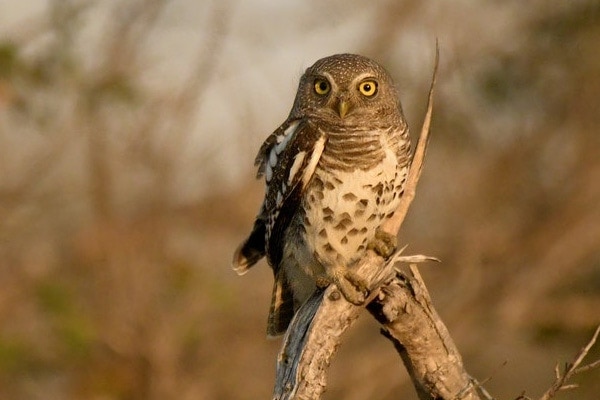
According to statistics, there are three types of owls:
- Nocturnal: Active during the night
- Crepuscular: Active from dawn to dusk
- Diurnal: Active during the day
By looking at the color of owl eyes, you can tell what time of day it is generally active. Nocturnal owls are known to have black eyes, crepuscular owls have orange owls, and diurnal owls have yellow eyes. Out of the three, nocturnal owls have the most numbers, while diurnal owls have the least.
In other words, you can hear owls any time of the day. If it’s during the daytime, you may be hearing the diurnal owls. Below are a few of the diurnal owls:
- Burrowing Owls: Burrowing owls breed on the southern border of the US and Mexico. These birds feature a brown back and wings with white spots and a white chest with brown spots. They have yellow eyes, which is common to diurnal birds. These birds often live in open and treeless areas like grasslands, deserts, agricultural fields, and even in vacant lots in cities.
- Snowy Owls: Snowy Owls are found wintering in Alaska and Canada, while their breeding grounds are primarily in the Arctic. As the name implies, the snowy owls are pure white birds, with females having black spots around their backs, wings, and chest areas. They also feature a pair of yellow eyes.
- Northern Pygmy-Owl: Northern Pygmy-Owls are tiny but ferocious daytime hunters. They are mostly found in the eastern parts of the US and some parts of Mexico. They feature a dark brown back with few white specks, a brown head with white spots, and a white chest with brown streaks. They also have a pair of yellow eyes.
- Northern Hawk Owl: Northern Hawk Owls breed in Alaska in Canada. As the name implies, these birds’ behavior resembles a hawk – perching on top of trees and hunting in the daytime. Like other diurnal birds, they also feature a pair of yellow eyes. Diurnal owls are pretty widespread, and it’s not uncommon that you hear them during the day and not only at night.
As for the reason why they hoot, owls are just like many small birds. They use tunes to communicate, and for owls, it’s hooting. They hoot to signify a couple of things:
- Courtship call
- Warning call
- Defense call
- Territorial call
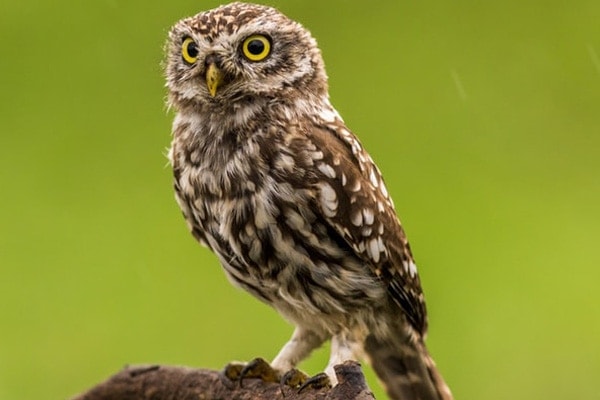
The sound or hoot they produce would usually depends on what they want to say. And it’s actually easy to tell. Below, I’ll share how you can differentiate the different owl hoots:
5 Reasons Why Owls Hoot
The main reasons that owls tend to hoot are very simple. In fact, there are five of them, and they include:
- They hoot to let other owls know that a predator is in their midst
- They hoot to scare away possible intruders while claiming territory for their own
- They hoot while approaching other owls. This is best known as an inspection call
- They hoot to properly announce themselves and let females know that they’re looking for a mate
- They hoot as a way to communicate with their mate. This type of hooting reaffirms their bond, and it’s also used for the partners to perform a duet
Territorial Calls
One of the reasons why owls hoot is to signify or claim territory.
During the breeding season, owls would go back to their breeding areas and look for finished nests made by other birds. Once they find one and claim it as their own home, they hoot to claim the territory so that other owls won’t come near it.
This call also sometimes helps attract females, telling them that they have found a nest.
Related Article: Buyer’s Guide For The Best Owl Nesting Boxes
Territorial owl calls differ for every species, but here’s what a barred owl’s territorial call sounds like:
Other owl territorial calls almost sound the same, too.
Related Article: Climate Change & Its Impact On Our Birds
Defense Calls
Owls also hoot as a way to defend themselves from predators.
Most of the time, before attacking, the owls would let out a loud screech or shriek to signify a threat to an attacker. They would continue to do this until the predator gives up and leaves their nest or territory.
Most of the time, they would also accompany this by spreading their wings to signify that they’re big.
Surprised Or Threatened
When owls feel threatened or surprised, they sometimes let out a low-pitched sound that is almost similar to a dog’s bark. This serves as a warning to whoever is around them to just keep their distance.
Sometimes, they would also growl, snark, or snap their beaks to tell predators or enemies to stay away.
Here’s a Great Horned Owl letting out some warning barks:
Courtship Hooting
During the breeding season, owls hoot to look for their mates.
Males would let out territorial calls to keep other male owls away from their nests. They will then let out a courtship call and wait until a female owl hoots back with a higher-pitched hoot. This goes on back and forth until the female finds the male’s territory.
Related articles: How to attract owls
Screaming Or Screeching
While most owls hoot, some owls communicate through screeching or screaming. This sometimes sounds like a woman screaming, which often alerts people, thinking there’s trouble. When the truth is, it’s just an owl.
Two owls known for screeching are eastern screech owls and western screech owls, which is where they got their name. Another owl you’ll hear with almost the same sound is a Barn owl.
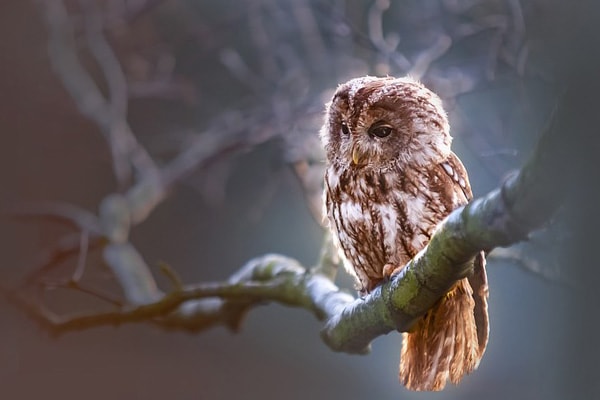
Owls are truly majestic creatures that possess wisdom and an affinity for the darkness of night, which is why we call people who like staying up late night owls. Another common phrase is to call a person a wise owl, which is a great choice because these beautiful birds are so smart.
Besides their incredible ability to hunt, these majestic creatures also make lots of interesting noises and sounds. In fact, they tend to make exceptional hooting sounds, which many of us know and recognize.
To answer the question “Why do owls hoot,” I’ll share a quote from the popular website
Owls hoot as a way of communicating and different types of hoots will convey different messages. The various sounds they make will help them adapt to their surroundings and protect themselves.
Wildlife Informer
Do All Owls Hoot?
Not every owl will hoot, although they typically have some type of screech or call.
For example, the barn owl technically doesn’t hoot, yet it does make certain sounds. The sounds that it makes typically present like a long and harsh scream, which usually lasts for about two seconds, and it’s quite jarring, to say the least.
Typically, the male barn owl is the one who often repeats this call. It will do so from the air while flying, more often than not. Female barn owls also have their own call, but they use it quite infrequently. This call is much softer, and it has a wavering tone to it. It’s often compared to a pairing sound.
Male barn owls will screech to female barn owls to let them know that they should inspect the nest site. When female barn owls make their purring call, they do so to beg a male for food.
Both male and female barn owls also make a hissing sound that lasts for 3-4 seconds. They make this sound to warn of predators or intruders attempting to disturb their nest.
American owls that do not hoot include the following:
Which Owls Hoot?
According to some experts,
The great horned owl and the barred owl produce the most recognizable hooting calls of all the American owls. As a general rule, the larger owl species tend to hoot while smaller species have higher-pitched voices.
birdfact
Flammulated owls make a very interesting exception to this rule. Even though it is a small bird, it produces a deep hoot, which is quite remarkable for a bird of its stature.
American owls that hoot include the following:
| Hooting Owls | Hooting Sound |
|---|---|
| Flammulated Owl | Repeated, low hoot. Song-like in nature |
| Great Horned Owl | One long hoot, followed by 2-3 short hoots |
| Barred Owl | Distinctive call that consists of 8-9 hoots |
| Long-Eared Owl | Low, breathy hoots |
| Spotted Owl | Slightly rasping, powerful, low-sounding hoots |
| Snowy Owl | Slightly rasping, powerful, low sounding hoots |
| Great Grey Owl | Soft sounding double hoot, 6-8 seconds long |
Which Owl Hoots Three Times?
The great horned owl is well known for its unmistakable hoot. Technically, it makes one really long hoot first. Then it will follow it up with 2-3 hoots that are much shorter. So technically, the great horned owl doesn’t hoot three times, but on occasion, it will also hoot four times.
Primarily, the great horned owl will initiate these three hoots in sequence to scare others from its habitat while also marking its territory. During the day, it might make this hoot if it feels threatened as well.
Which Owl Hoots Four Times?
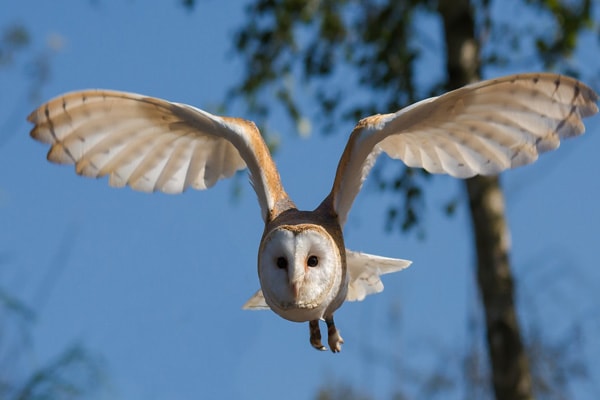
The spotted owl is an interesting creature because it has 13 different whistling, barking, or hooting calls. One of its calls consists of four who did notes.
Both adult males and females like to use this call. They do so to Mark their territory, defend their territory, and more. In certain instances, when the male uses these four hooting notes, he does so to signify that he is delivering food to a female spotted owl.
The call typically consists of four notes, with the two notes in the middle being very close together in deep and resonant tones for the males and more high-pitched tones for the females.
Want To Attract Owls To Your Yard?
Make your yard more inviting to your hooting friends! Click the button below to find out how!
Do Owls Hoot At Each Other?
Yes, many owls are known to hoot at each other. They like to hoot at one another as a way to send messages. One such message is to let another owl or group of owls know that they have discovered and claimed a particular territory.
In other instances, male and female owls might hoot at each other during mating season. This is part of their mating ritual, duet, or dance, as it were.
Which Other Sounds Do Owls Make?
Owls make a number of different sounds besides their impressive hoots. More often than not, you’ll hear owls make the following sounds:
- Beak snaps
- Barks
- Whistles
- Yelps
- Hoots
- Coos
- Cries
Five Common Owls and Their Sounds
Now that you’re aware of why owls hoot let’s take a look at the five most common owls with very distinct calls.
1. Barred Owl
The Barred Owl’s call is very distinct. Most people describe it as a repeated “Who cooks for you? Who cooks for you?” Cute, right? Who would know that an owl can also act as our mother? They repeat the same phrase twice, prolonging the end of their second repetition.
2. Barn Owl
The Barn Owl is truly a beautiful owl known for its ghostly face. However, their sound can either surprise or scare you when you’re walking in the forest alone.
These birds can be heard with the “k-r-r-r-r-ick” sound to let their presence known to other owls. However, if it’s a distress call, it’s even longer.
3. Great Horned Owl
The Great Horned Owl is the largest owl in North America. As the name implies, these birds have two hornlike ears and can be very aggressive, hunting down birds and mammals larger than them.
However, despite the bird’s devilish looks, their hoot is not as scary. The birds let out a simple and rhythmic hooting that sounds like “hoo-h’HOO-hoo-hoo-hoo”. They use this sound as their territorial and mating call.
4. Burrowing Owl
The Burrowing Owls are medium-sized birds with a very high-pitched voice. It sounds like a simple and repetitive “coo-cooo, coo-cooo”. You might also hear a short wheezing at the end. To keep predators away from their nests, burrowing owls can sometimes mimic the sound of a rattlesnake to keep the enemies away.
5. Eastern Screech-Owl
As the name implies, eastern screech owls are known for their screeching sound. This is a sound they often used when distressed. However, these birds also have other softer sounds like the trill, which requires them to only vibrate their voice box.
These birds are known to be impressive vocalists that use different vibrations and rhythms to create conversations.
When Will You Mostly Hear An Owl Hooting?
Owls often make their first sound before they even hatch from the egg. As they grow, owls first develop a chirping sound. And as they grow, that’s when they practice vocalizing.
Males, in particular, practice their first hoots in the first winter. But as they mature, you’ll often hear their hooting sounds a lot during the breeding season as they attract mates.
As these are nocturnal birds, owls are often heard at night as soon as the sun sets. They’ll also often be heard right before the sun rises and before they go to bed. But of course, since some owls are diurnal, you would also hear them in the morning.
However, when you hear owls near your window, chances are, that’s not an owl.
Owls don’t hang around near windows. They are solitary creatures, and they don’t visit bird feeders. So, they would not most likely spend a lot of time near your window.
However, some birds are confident to be near your yard and resemble an owl’s sound. One particular bird is the Mourning Dove. For those who are not yet accustomed to an owl’s sound, it’s easy to mistake these birds’ sounds like that for an owl.
Listen closely to their call here:
If you close your eyes, you might mistake them for an owl. But it’s not.
Why Do Owls Hoot At Night?
Owls tend to hoot at night because they are mostly active during the nighttime hours.
Why Do Owls Hoot In The Morning?
Certain owls will hoot during the day simply because they are active during the daytime or because they are considered diurnal. Mostly, they will hoot to protect their territory from invaders, or they will do so when making a territorial call.
When Is The Most Common Time To Hear An Owl Hooting?
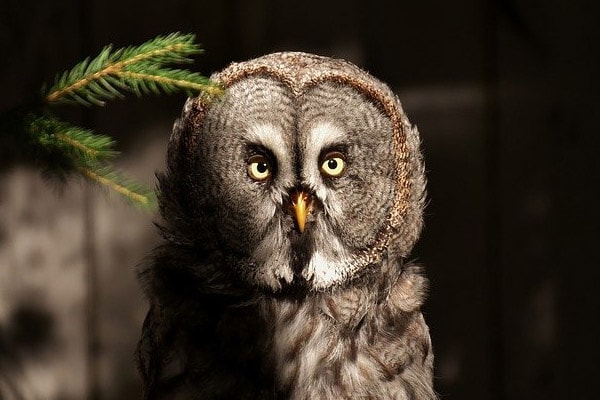
It’s most common to hear an owl hooting at night. Besides the Northern Hawk Owl and the Northern Pygmy Owl, all other owls are awake at night. So, it’s most common to hear their hooting, screeching, and calling when it is dark outside.
Do Owls Hoot During The Day?
The Northern Hawk Owl and Northern Pygmy Owl are diurnal in nature, meaning they are awake and active during the day. It shouldn’t surprise anyone to learn that since these owls are active during the day, they are also hooting, screeching, and whistling during the day.
What Does It Mean When You Hear An Owl Hooting?
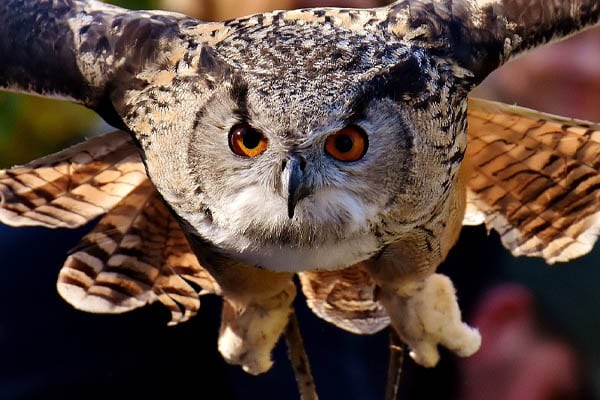
Most people believe that hearing and owl hooting is a sign of good luck. Since many consider owls to be very spiritual animals, their hooting noises deliver positive vibes to those who have heard them. This is especially true if you happen to hear an owl hooting outside your home.
Why Do Owls Hoot In The Winter?
Believe it or not, winter is a particular time of year known as “hooting season” for owls.
Why? Mail owls will increase their hoots and calls during this time of year. They do so in an effort to find a new breeding partner.
Listen for owl calls to discover if any are nearby or in the vicinity of your home.
Is Hearing An Owl A Good Omen?
It’s definitely a good omen to hear an owl. In fact, many people believe that, in most cases, their life is going to improve in some form or another. In fact, hearing and owl hooting is usually a great indication that their general well-being will certainly improve.
Final Thoughts On Why Owls Hoot At Sunrise and Sunset
Owls hoot as a way to communicate, whether it’s to defend their territory, call out for a mate, protect themselves, and a lot more. But owls don’t just create a hooting sound. Owls can also scream, screech, whistle, bark, shriek, coo, hiss, and many more.
Regardless of its sunrise or sunset, owls can be heard at any time. This is because even if most owls are nocturnal, there are still many diurnal owls, too.
Related Articles:

